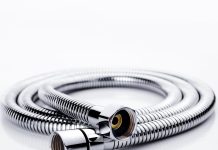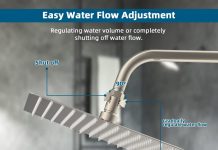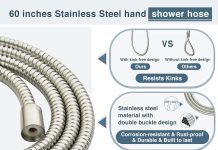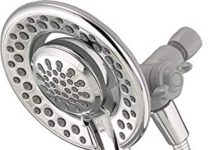Have you ever wondered why your shower hose constantly seems to spring a leak? It can be frustrating dealing with the inconvenience of water dripping all over your bathroom floor. In this article, we will explore the common causes of shower hose leaks and provide you with some simple solutions to keep your showers leak-free. Say goodbye to the wet mess and hello to a hassle-free showering experience!
Table of Contents
Possible Causes of Shower Hose Leaks
Old or Worn Out Shower Hose
One possible cause of a leaking shower hose is its age. Over time, the hose may become old and worn out, leading to cracks or weak spots which can result in leaks. Regular wear and tear from daily use can gradually deteriorate the hose, making it more susceptible to leaks. If you notice that your shower hose is quite old, it may be time to consider replacing it to prevent further leaks.
Loose Connections
Another common cause of shower hose leaks is loose connections. The fittings that connect the shower hose to the showerhead or water source can come loose over time due to repeated use or inadequate installation. When these connections become loose, it allows water to escape and cause leaks. Checking and tightening the connections can often help resolve the issue and prevent future leaks.
Damaged or Faulty Washer
The washer inside the shower hose can also be a potential cause of leaks. If the washer becomes damaged or worn out, water can start to leak through the holes or gaps. Inspecting the washer and replacing it if needed can help fix the issue. It’s important to ensure that the washer is properly seated and creates a tight seal to prevent leaks.
High Water Pressure
High water pressure can put excessive strain on the shower hose, leading to leaks. When the water pressure is too high, it can cause the hose to expand beyond its capacity and develop cracks or weak points. Installing a pressure regulator can help control the water pressure and prevent leaks caused by excessive force on the hose.
Incorrect Installation
Improper installation of the shower hose can also be a culprit behind leaks. If the hose is not installed correctly or securely, it can lead to water seepage and leaks. It’s essential to follow proper installation techniques provided by the manufacturer or seek professional help to ensure the shower hose is securely attached and tightly sealed.
Age of the Shower Hose
Similar to other household items, the age of the shower hose itself can contribute to leaks. As the hose ages, it becomes more prone to wear and tear, making it susceptible to developing cracks or weak spots. Considering the age of your shower hose is crucial when troubleshooting leaks, as it may indicate the need for replacement.
Chemical Damage
Exposure to certain chemicals can deteriorate the materials of the shower hose and ultimately lead to leaks. Harsh cleaning products or chemicals found in hard water can degrade the hose over time, making it more vulnerable to leaks. If you suspect chemical damage as the cause of your leaking shower hose, it may be helpful to switch to gentler cleaning products or use a water softener to protect the hose.
Hard Water Deposits
The build-up of minerals found in hard water can accumulate inside the shower hose, obstructing the flow of water and causing leaks. These deposits can clog the hose and put additional strain on the materials, leading to cracks or ruptures. Regularly inspecting the shower hose for signs of hard water deposits and cleaning them out can help prevent leaks.
Intrusion of Debris or Foreign Objects
Sometimes, foreign objects or debris can find their way into the shower hose, causing blockages and leaks. Small particles or debris can obstruct the water flow and create pressure points that lead to leaks. It’s important to regularly check for any obstructions and clear them out to ensure the hose functions properly and remains leak-free.
Excessive Heat or Extreme Cold
Extreme temperatures can also contribute to shower hose leaks. Exposure to excessive heat or extreme cold can degrade the materials of the hose, making them more susceptible to cracks or weak spots. It’s important to maintain stable temperature conditions in your bathroom and protect the shower hose from extreme temperature fluctuations to prevent leaks.
Signs and Symptoms of a Leaking Shower Hose
Visible Water Drips or Leaks
One of the most apparent signs of a leaking shower hose is the presence of visible water drips or leaks. If you notice water dripping from the hose, it’s a clear indication that there is a leak somewhere in the system.
Water Stains or Dampness
Leaking shower hoses can also cause water stains or dampness around the shower area. You may notice discoloration on the walls or floors, indicating water leakage that has been absorbed by the surrounding surfaces.
Decreased Water Pressure
A leaking shower hose can result in decreased water pressure when using the shower. If you suddenly notice a significant drop in water pressure, it may be due to a leak in the hose.
Mold or Mildew Growth
Leaking water can create a moist environment, which is conducive to the growth of mold and mildew. If you see mold or mildew forming in your bathroom, it could be a sign of a leaking shower hose.
Unusual Sounds or Vibrations
In some cases, a leaking shower hose may produce unusual sounds or vibrations when water flows through it. You might notice rattling, vibrating, or hissing noises coming from the hose, which can indicate a leak.
Sudden Increase in Water Bills
Undetected leaks in the shower hose can lead to a sudden increase in water bills. If you notice a significant spike in your water usage without any apparent reason, it’s worth checking for leaks in your shower hose.
Difficulty Adjusting Shower Temperature
When a shower hose is leaking, it can disrupt the water temperature control. You may find it challenging to adjust the water temperature as the leak can interfere with the balance of hot and cold water.
Irregular Shower Sprays
Leakage in the shower hose can cause irregular or uneven shower sprays. You may experience inconsistent water flow or notice water spraying in unexpected directions.
Inconsistent Water Flow
Similarly, a leaking shower hose can result in inconsistent water flow. You may observe water flow disruptions or interruptions during your shower due to the leak.
Identifying the Specific Cause of Leaks
Inspecting the Shower Hose
When trying to identify the specific cause of a leaking shower hose, it’s essential to start by inspecting the hose itself. Look for any visible cracks, holes, or weak spots along the length of the hose. Pay close attention to the connections and the areas where the hose bends, as these are common areas for leaks to occur.
Checking the Connections
Next, check the connections at both ends of the shower hose. Ensure that they are securely fastened and tightened. If you notice any loose or wobbly connections, tightening them can often resolve the issue and eliminate leaks.
Examining the Washer
Inspect the washer inside the shower hose and check for any damage or wear. If the washer is worn out or cracked, it can allow water to seep through and cause leaks. Replace the washer if necessary and ensure that it is properly seated to create a tight seal.
Measuring Water Pressure
Testing the water pressure in your shower can help determine if high water pressure is the cause of the leak. Use a water pressure gauge to measure the pressure coming from the showerhead and check if it exceeds the recommended levels. If the pressure is too high, installing a pressure regulator can help prevent leaks caused by excessive force on the hose.
Reviewing Installation Methods
If the shower hose is not installed correctly, it can lead to leaks. Review the installation method used to attach the hose to the showerhead or water source. Check if all the steps were followed correctly and if the hose is tightly secured. Improper installation can result in loose connections, which can cause water to leak.
Considering the Age of the Hose
The age of the shower hose can often provide insights into the cause of leaks. If the hose is quite old or has been in use for a long time, it is more likely to develop cracks or weak spots. Considering the age of the hose can help determine if replacement is necessary to resolve the leaks.
Examining Chemical Exposure
If you suspect chemical damage as the cause of the leaks, take into account the cleaning products and chemicals used in your bathroom. Harsh chemicals or products containing abrasive substances can degrade the materials of the hose over time. Consider switching to gentler cleaning products or using a water softener to minimize chemical damage and prevent further leaks.
Inspecting for Hard Water Deposits
Inspecting the inside of the shower hose for hard water deposits is essential. Over time, minerals from hard water can accumulate inside the hose, obstructing the flow of water and causing leaks. Use a flashlight to examine the inner surface of the hose and check for any signs of mineral build-up. Cleaning the hose regularly and using water softening techniques can help prevent the formation of hard water deposits.
Clearing Debris or Foreign Objects
Inspect the hose and connections for any debris or foreign objects that may be causing blockages and leaks. Remove any particles or obstructions that may be obstructing the flow of water. Clearing the hose and connections of debris can help restore proper water flow and prevent leaks.
Assessing the Surrounding Temperature
Consider if extreme temperatures in the bathroom are contributing to the leaks. Exposure to excessive heat or extreme cold over time can weaken the materials of the shower hose, making it more prone to cracks or ruptures. Maintaining stable temperature conditions and protecting the hose from extreme temperature fluctuations can help prevent leaks.
Prevention and Maintenance Tips
Regularly Inspect and Replace Shower Hoses
To prevent shower hose leaks, it is crucial to regularly inspect the condition of the hose. Check for any signs of wear and tear, such as cracks or weak spots. If the hose shows signs of aging or damage, it is advisable to replace it to prevent leaks.
Ensure Tight and Secure Connections
Properly installed and secure connections are essential to prevent leaks. Regularly check the connections at both ends of the shower hose and ensure they are tightly fastened. If you notice any loose or wobbly connections, tighten them to prevent water from escaping.
Replace Washers When Necessary
The washer inside the shower hose plays a vital role in preventing leaks. If the washer becomes damaged or worn out, it can compromise the seal and allow water to leak through. Regularly inspect the washer and replace it if necessary to maintain a tight seal and prevent leaks.
Install a Pressure Regulator
If high water pressure is a recurring issue in your home, consider installing a pressure regulator. A pressure regulator can help control and reduce the water pressure, preventing excessive force on the shower hose and minimizing the risk of leaks.
Follow Proper Installation Techniques
When installing or replacing a shower hose, it is important to follow the manufacturer’s instructions or seek professional help. Proper installation techniques ensure that the hose is securely attached and tightly sealed, minimizing the chances of leaks in the future.
Consider the Lifespan of the Hose
Every shower hose has a lifespan, and considering this is important when troubleshooting leaks. Understanding the age of your hose can help determine if it is time for a replacement. If your hose has been in use for many years and is showing signs of wear, replacing it can prevent leaks and ensure efficient water flow.
Protect Against Chemical Damage
To prevent leaks caused by chemical damage, choose gentle cleaning products that are safe for use in bathrooms. Avoid using abrasive substances or harsh chemicals that can degrade the materials of the shower hose. Additionally, consider installing a water softener to minimize the harmful effects of hard water on the hose.
Guard Against Hard Water Deposits
Regularly cleaning the shower hose and implementing water softening techniques can help guard against hard water deposits. Removing mineral build-up from the hose ensures proper water flow and reduces the risk of leaks.
Keep the Shower Area Clean
Maintaining cleanliness in the shower area can contribute to preventing leaks. Regularly clean the showerhead and the surrounding surfaces to prevent the accumulation of dirt, debris, or mold, which can potentially cause leaks in the shower hose.
Maintain Stable Temperature Conditions
To prevent leaks caused by extreme temperatures, it is crucial to maintain stable temperature conditions in your bathroom. Avoid exposing the shower hose to excessive heat or extreme cold, as this can weaken its materials and lead to leaks. Proper insulation and ventilation can help regulate the temperature in the bathroom and protect the hose.
Repairing or Replacing a Leaking Shower Hose
Repairing Small Leaks
If the leaks in your shower hose are minor, you may be able to repair them yourself. Start by identifying the source of the leak and clean the area thoroughly. Apply a sealant or waterproof tape to seal the leaky spot. Allow the sealant to dry completely before using the shower again.
Replacing a Damaged Shower Hose
In some cases, repairing a leaking shower hose may not be possible, or it may be more cost-effective to replace the entire hose. To replace a damaged shower hose, start by turning off the water supply and unscrewing the connections. Remove the old hose, clean the thread and fittings, and attach the new hose securely. Tighten the connections and turn on the water supply to check for any leaks.
Seeking Professional Help
If you are unsure of how to repair or replace a leaking shower hose, or if the issue persists despite your efforts, it is advisable to seek professional help. A qualified plumber or bathroom specialist can assess the situation and provide the necessary repairs or replacements to fix the leaks.
Considering DIY Solutions
For those with some DIY skills, there may be additional solutions to consider. Online tutorials and forums may provide guidance on repairing specific types of shower hoses or troubleshooting leaks. However, it is important to proceed with caution and only attempt DIY solutions if you have the necessary knowledge and expertise.
Choosing the Right Replacement Hose
When replacing a leaking shower hose, it is essential to choose the right replacement. Consider the length, material, and compatibility with your current shower setup. Consult the manufacturer’s recommendations or seek advice from a professional to ensure you select a suitable replacement hose.
Replacing Washers and Seals
If the washer or seals inside the shower hose are the cause of the leak, it is important to replace them. Purchase new washers or seals that are compatible with your shower hose and follow the manufacturer’s instructions to ensure proper installation.
Proper Installation Techniques
Correct installation techniques are crucial when replacing a leaking shower hose. Follow the manufacturer’s instructions or consult a professional if you are unsure of the proper installation method. Ensuring that the hose is securely attached and tightly sealed will help prevent future leaks.
Addressing Underlying Issues
If your shower hose keeps leaking despite repairs or replacements, it may indicate an underlying issue with the plumbing system. In such cases, it is essential to investigate the entire system or consult with a professional plumber to identify and address any hidden problems contributing to the recurring leaks.
Taking Precautions for Future Leaks
Once you have repaired or replaced a leaking shower hose, it is important to take precautions to prevent future leaks. Regularly inspect the hose, check the connections, and ensure proper water pressure. Implement preventive maintenance measures, such as clearing out debris and using gentle cleaning products, to prolong the life of the hose and minimize the risk of leaks.
Regular Maintenance and Inspection
To ensure the longevity and functionality of your shower hose, regular maintenance and inspection are necessary. Clean the hose and connections periodically, checking for any signs of wear or damage. By addressing any potential issues early on, you can prevent leaks and maintain a leak-free showering experience.






















